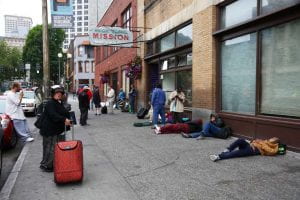by Kelsey Johnson (guest blogger)

As of 2018, approximately 38.1 million people in the U.S. live below the poverty line. Furthermore, on a given night, over 550,000 people experienced homelessness.
Of those numbers, more than 800,000 Alabama residents live in poverty, making it the sixth poorest state in the U.S. Approximately 3,434 people experience homelessness in Alabama on a given night.
Poverty and a lack of adequate housing are considered human rights violations, as they interfere significantly with an individual’s ability to live safely and with dignity. For people experiencing poverty and/or homelessness, these situations impact all aspects of their lives, especially their physical health.
One way that these health issues manifest is in the prevalence of sexually transmitted diseases (STDs) and HIV/AIDS among these populations. Overall, rates of STDs, particularly chlamydia, gonorrhea, and syphilis, are at an all-time high in the U.S., according to a 2019 report from the Center for Disease Control and Prevention (CDC). In 2017-18, there were nearly 2.5 million total reported cases of the three STDs, including over 1.7 million cases of chlamydia, 583,405 cases of gonorrhea, and 115,045 cases of syphilis.
Two urban areas in Alabama, Montgomery and Birmingham, are among the top 20 U.S. cities reporting the highest rates of STDs, including HIV, syphilis, gonorrhea, and chlamydia. Mobile and Huntsville also ranked in the top 100. Alabama has the fourth highest rate of gonorrhea infections in the country. Additionally, as of 2016, there were 12,643 people in Alabama living with HIV.
While the CDC report examined STD prevalence among various demographics, it did not focus on STD rates among low-income or homeless populations. However, a literature review published in 2018 in the journal Sexually Transmitted Diseases found that STD prevalence ranged from 2.1% to 52.5% among the homeless adult population.
This study also identified many of the factors that increase the risks of contracting an STD among homeless individuals. A number of these risk factors also apply to individuals living in poverty, even if they have stable housing. Additional studies offer more insight into the recent rise in STD cases, as well as recommendations for how to decrease their spread among all populations.
Factors contributing to STD prevalence among low-income and homeless populations
There are several factors that contribute to the prevalence of STDs in low-incomes and homeless communities, including lack of access to affordable prevention and treatment options; lack of comprehensive sex education; the comorbidity of issues like mental illness or substance abuse, and the stigma surrounding STDs.
According to a 2019 report by the National Coalition of STD Directors, “…poverty is both a cause of infection, and a barrier to the ability to seek care. Poorer populations are less likely to receive appropriate sexual health education, suffer higher rates of substance abuse, and may have more trouble accessing sexual health services.”
Poor or homeless individuals are less likely to have health insurance, or resources to pay for out-of-pocket healthcare costs. Many individuals living in southern states, including Alabama, fall into what is known as the coverage gap, meaning they make too much money to qualify for Medicaid, but not enough to pay for health insurance.
Even if individuals have health insurance, their coverage may be limited to certain providers or services, and may exclude STD testing or treatment. The time and money it takes to travel to healthcare facilities, especially in predominantly rural states like Alabama, also present a barrier to care, even for insured individuals.
Additionally, budget cuts have forced many STD clinics to close or reduce their services. The loss of these clinics is harmful because not only do they often provide STD testing and treatment on a sliding fee scale, they are staffed by individuals with specialized knowledge in diagnosing and treating STDs.
The other primary factor in higher STD rates is a lack of comprehensive sex education. As the NCSD report states, “States typically define the broad parameters of sexual health education in public schools. Not surprisingly, these parameters vary widely among states.” Studies show a correalation between insufficient sex education and higher STD rates. Kathie Hiers, the CEO of AIDS Alabama, says the state represents a “perfect storm” for the spread of AIDS and other STDs, in part because of its “poor educational systems that often ignore sexual health.”
This lack of education about STDs also perpetuates the stigma surrounding them, which prevents people from seeking treatment, according to Hiers. Other conditions that are prevalent among poor and homeless populations, including mental illness, incarceration history, and intravenous drug use, also make individuals more susceptible to STDs, and present barriers to seeking treatment.
How to prevent the spread of STDs among low-income and homeless populations
The studies and experts cited in this post offer several recommendations for steps that can be taken, nationwide and in individual states, to decrease the spread of STDs among low-income and homeless populations, including:
- Removing financial barriers to healthcare, including adopting Medicaid expansion. The Alabama Hospital Association estimates that by adopting Medicaid expansion, an additional 300,000 residents would be eligible for health insurance.
- Increasing or restoring funding to public health agencies and STD clinics that provide free or low-cost testing and treatment.
- Improving access to healthcare facilities through transportation and operating on evenings and weekends.
- Providing comprehensive sex education in schools. In 2019, the Alabama House of Representatives failed to address a bill that would have made the state’s sex education curriculum more scientifically and medically accurate. The bill would have updated the curriculum’s language to address “sexually transmitted diseases” as “sexually transmitted infections,” which is considered less stigmatizing.
- Expanding resources to support homeless individuals, and increasing their access to stable housing. A 2016 report by the Homelessness in Alabama Project offered several specific recommendations for addressing homelessness in Alabama.
Additional Resources

